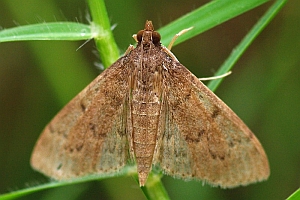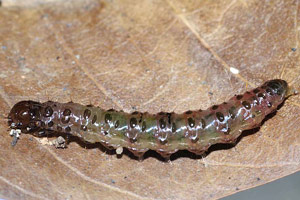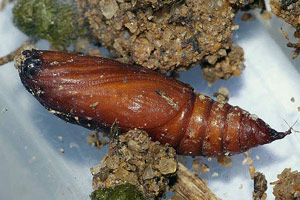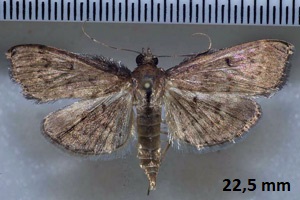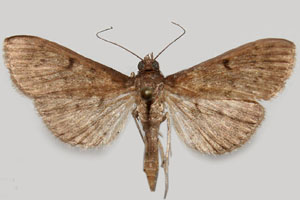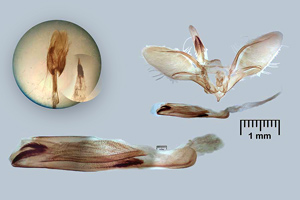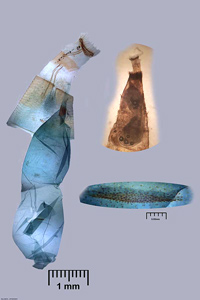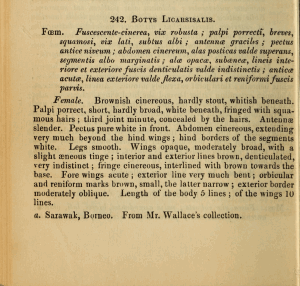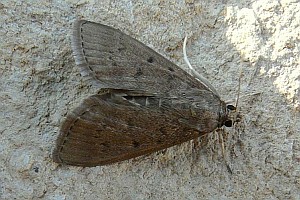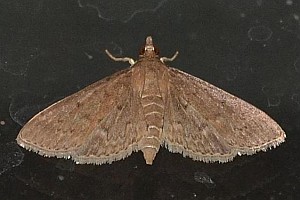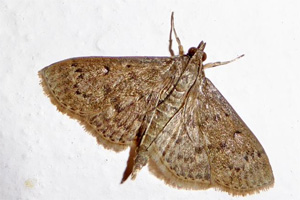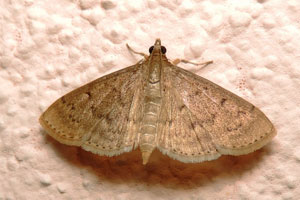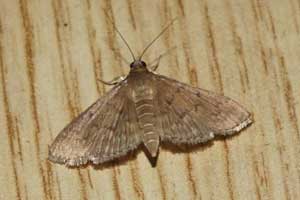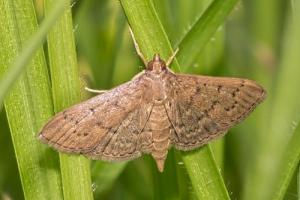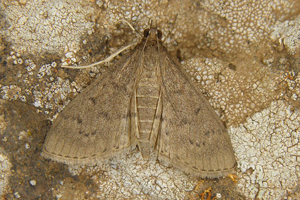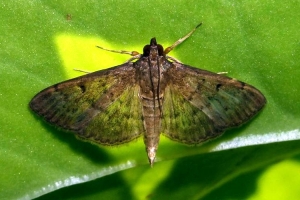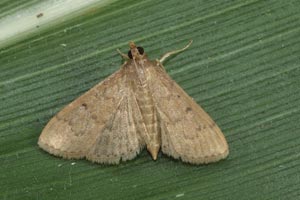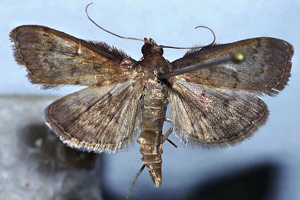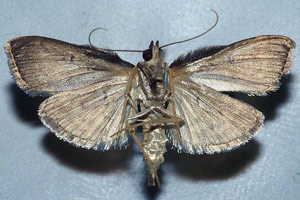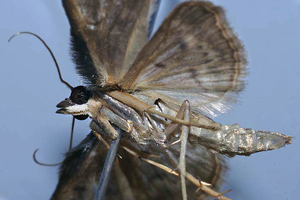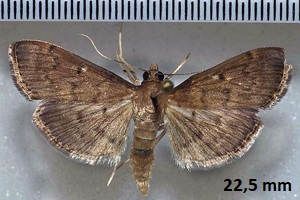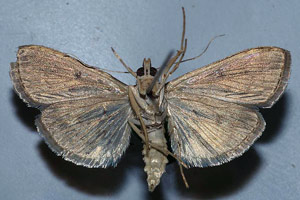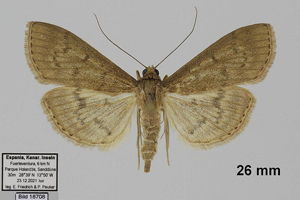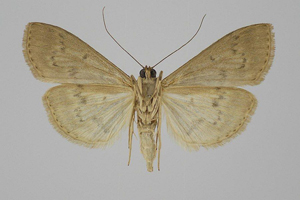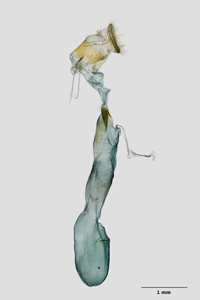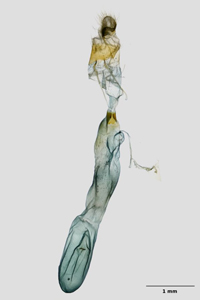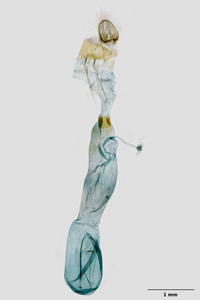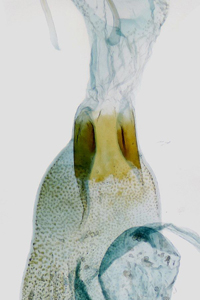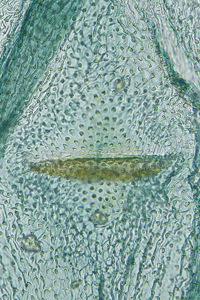1. Lebendfotos
1.1. Falter
1.2. Raupe
1.3. Puppe
2. Diagnose
2.1. Männchen
2.2. Weibchen
3. Genitalien
3.1. Männchen
3.2. Weibchen
3.3. Erstbeschreibung
4. Weitere Informationen
4.1. Andere Kombinationen
- Botys licarsisalis Walker, 1859 [Originalkombination]
4.2. Synonyme
- Herpetogramma aegrotalis sensu auct. europ., nec (Zeller, 1852)
- Botys pharaxalis Walker, 1859
- Botys immundalis Walker, [1866]
- Entephria fumidalis Walker, [1866]
- Botys serotinalis De Joannis, 1888
4.3. Faunistik
Nach der [Fauna Europaea, last update 29 August 2013 | version 2.6.2] auf Zypern, den Kanaren, Madeira, Azoren, in Portugal, Großbritannien und - zweifelhaft bzw. eingeschleppte Einzelexemplare - auch Schweden.
Auf der englischen Seite von Hants Moths [Hants Moths] ist zu lesen: "A species from the tropics of Africa, first recorded in Europe on the Algarve and on Fuerteventura in 1997 and subsequently becoming established in Spain and Portugal before being recorded for the first time in Britain at Freshwater, Isle of Wight on 9 November 1998, and then as a migrant a handful of times on the south coast of England from Kent to the Isles of Scilly."
Sammut (2005) korrigiert die Angaben zu 3 Arten von Malta, eine davon: Herpetogramma aegrotalis. Alle 31 untersuchten Exemplare verschiedener Jahre und Fundorte, die in der Vergangenheit unter H. aegrotalis abgelegt waren, gehörten - wie überall in Europa - zu H. licarsisalis! Sammut (2005) schreibt dazu: "Herpetogramma licarsisalis is a recent introduction in the Maltese Islands. The earliest records date back only to 1989 and these coincide with dates of recordings for the other European countries. It appears to be already well established and the time of flight (October to December) suggests that the species is univoltine.” Herpetogramma aegrotalis kommt nach derzeitigem Kenntnisstand nicht in Europa vor.
Grange (2014) meldet den Erstnachweis für Frankreich: 2 Falter am 31. Oktober 2013 bei Ramatuelle (Dép. Var), 155 m. Er hält das für eine Folge einer Zuwanderung zur Zeit des ungewöhnlich günstigen Monats Oktober 2013.
Nach Pérez De-Gregorio & Requena (2023: 88) war die Art aus Spanien neben den Funden im Südwesten des Landes nur durch ein Einzelexemplar vom 7. September 1998 (leg. Vives) aus Tarragona (Katalonien) bekannt, hinzu kommt ein von Pérez De-Gregorio am 8. Oktober 2018 im Parc de la Ciutadella in Barcelona gesammeltes Tier. Wie das Tier aus Südfrankreich sind auch diese nordspanischen Einzelfunde auf wandernde Exemplare zurückzuführen.
(Autor: Erwin Rennwald)
4.4. Literatur
- Goater, B. & S. A. Knill-Jones (1999): Herpetogramma licarsisalis (Walker, 1859) (Lepidoptera: Pyralidae), the Grass Webworm, new to Britain. — Entomologist's Gazette 50 (2): 71-74.
- Grange, J.-C. (2014): Herpetogramma licarsisalis (Walker, 1859), une nouvelle pyrale pour la France observée dans le Var (Lepidoptera, Crambidae, Spilomelinae). — Revue de l'Association Roussillonnaise d'Entomologie 23 (2): 64.
- Pérez De-Gregorio, J.J. & E. Requena (2023): Microlepidòpters nous o interessants per la fauna catalana, XIII. Microlépidoptères nouveaux ou intéressants pour la faune catalane, XIII (Lepidoptera, Pyralidae, Crambidae). — Revue de l’Association Roussillonnaise d’Entomologie, 32 (2): 73-92.
- Sammut, P. (2005): The correct identity of three Pyralidae moths from the Maltese Islands (Lepidoptera: Pyralidae). — SHILAP Revista de lepidopterología 33 (130): 235-238. [PDF Arbeit auf redalyc.org]
- Erstbeschreibung: Walker, F. (1859): List of the specimens of lepidopterous insects in the collection of the British Museum 18: 509-798.




![Vorkommen in Großbritannien [Agassiz, Beavan & Heckford (2013): Checklist of the Lepidoptera of the British Isles]](/res/img/flag/gb.gif)
![Einzelnachweis in Frankreich (europäisches Territorium ohne Korsika) [Vandromme et al. (2020): Liste systématique et taxinomique des Lépidoptères de France]](/res/img/flag/fr.gif)
![Vorkommen in Spanien (Festland) [Garre & al. (2021)]](/res/img/flag/es.gif)
![Vorkommen auf den Kanarischen Inseln [Vives Moreno, A. (2014)]](/res/img/flag/es-cn.png)
![Vorkommen in Portugal (Festland) [Corley (2015): Lepidoptera of Continental Portugal]](/res/img/flag/pt.gif)
![Vorkommen auf Madeira [Aguiar & Karsholt (2006)]](/res/img/flag/pt-ma.png)
![Vorkommen auf den Azoren [Vieira & Karsholt (2010)]](/res/img/flag/pt-az.png)


![Vorkommen auf den Pelagischen Inseln [Slamka (2013)]](/res/img/flag/it.gif)

![Vorkommen in Kroatien [Gumhalter (2021)]](/res/img/flag/hr.gif)
![Vorkommen auf Kreta [Slamka (2013 [Pyr. Eur. Vol. 3])]](/res/img/flag/gr.gif)
![Vorkommen auf Zypern [Slamka (2013)]](/res/img/flag/cy.gif)
![Vorkommen im asiatischen Teil der Türkei [Koçak & Kemal (2018)]](/res/img/flag/tr.gif)
![Vorkommen in Syrien [Slamka (2013)]](/res/img/flag/sy.gif)
![Vorkommen in Iran [Rajaei & al. (2023)]](/res/img/flag/ir.gif)
![Vorkommen in Libanon [Slamka (2013 [Pyr. Eur. Vol. 3])]](/res/img/flag/lb.gif)
![Vorkommen in Israel [Kravchenko, Poltavsky, Segerer, Speidel & Müller (2020)]](/res/img/flag/il.gif)
![Vorkommen in Malaysia [locus typicus: Borneo]](/res/img/flag/my.gif)
![Vorkommen in Tunesien [Boness & Schmitz (2002)]](/res/img/flag/tn.gif)
![Vorkommen in Kap Verde [Foto im Forum]](/res/img/flag/cv.gif)
![Vorkommen in Ägypten (gesamtes Territorium) [Slamka (2013)]](/res/img/flag/eg.gif)
